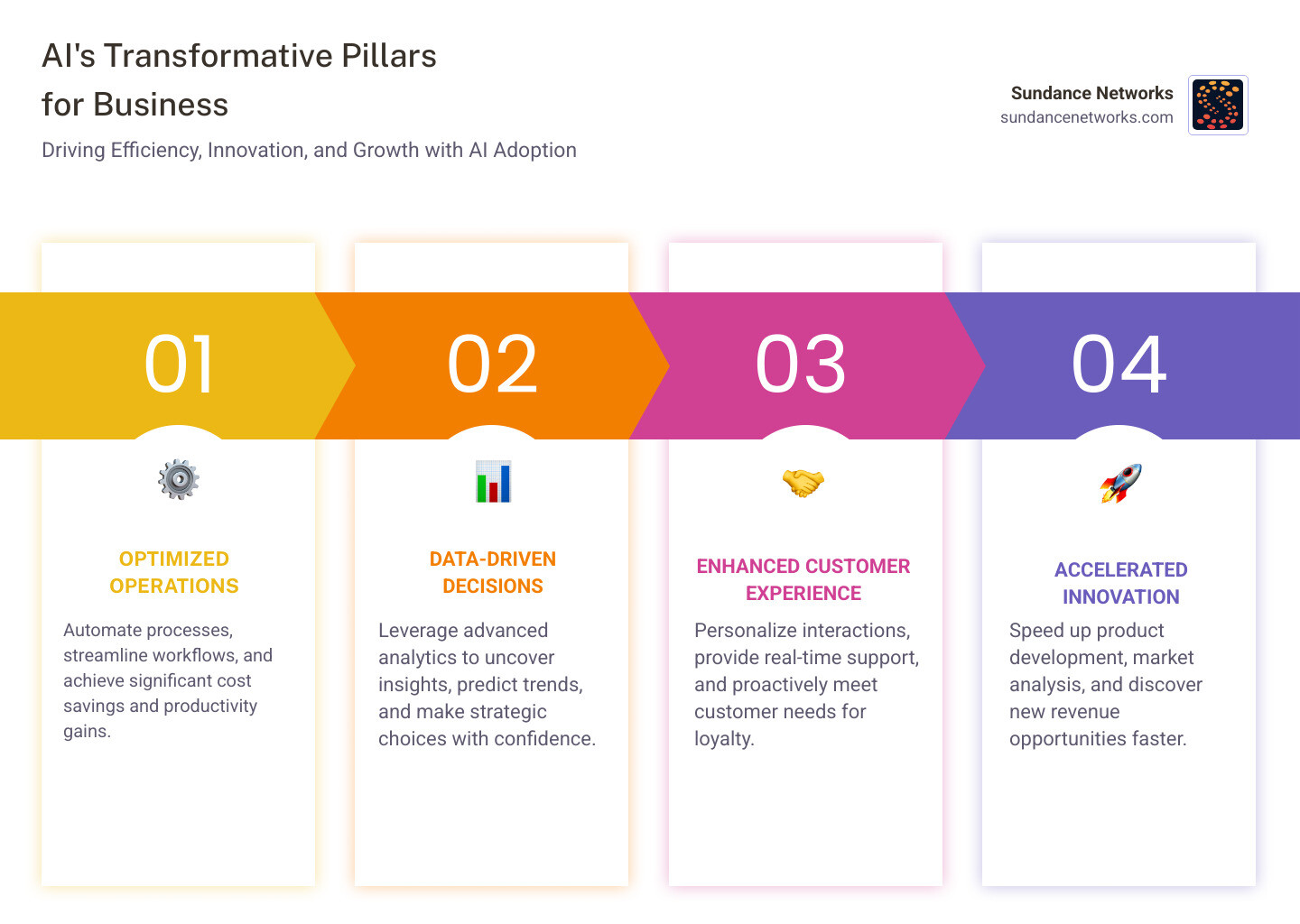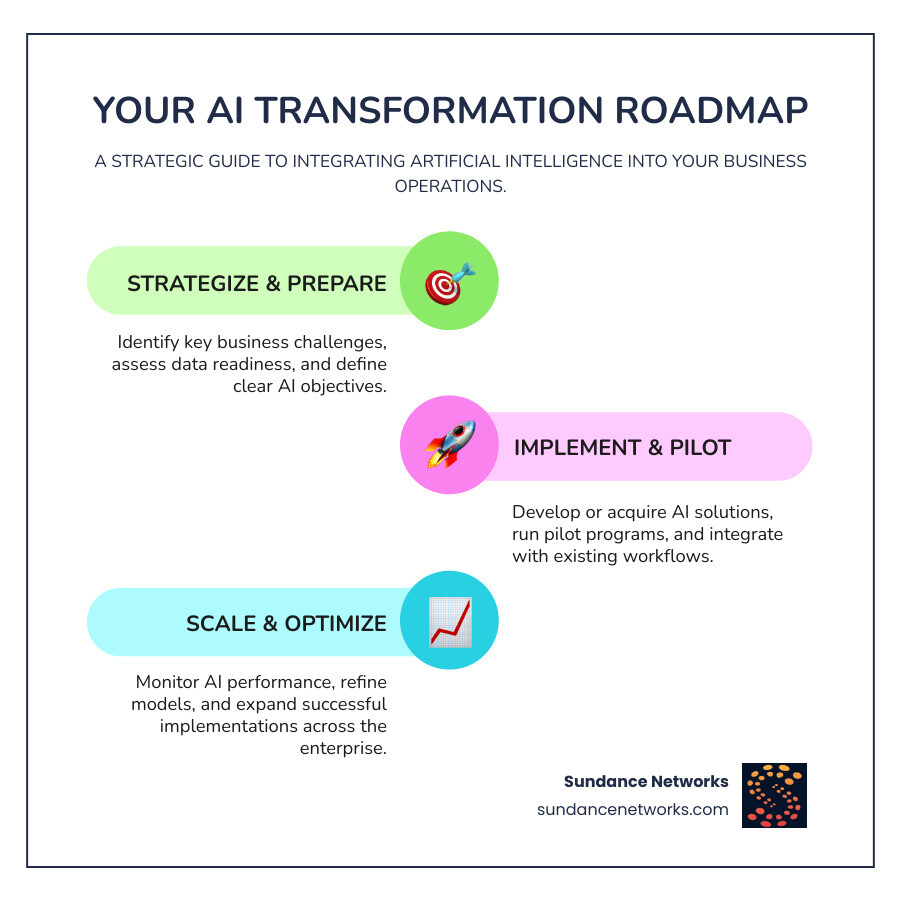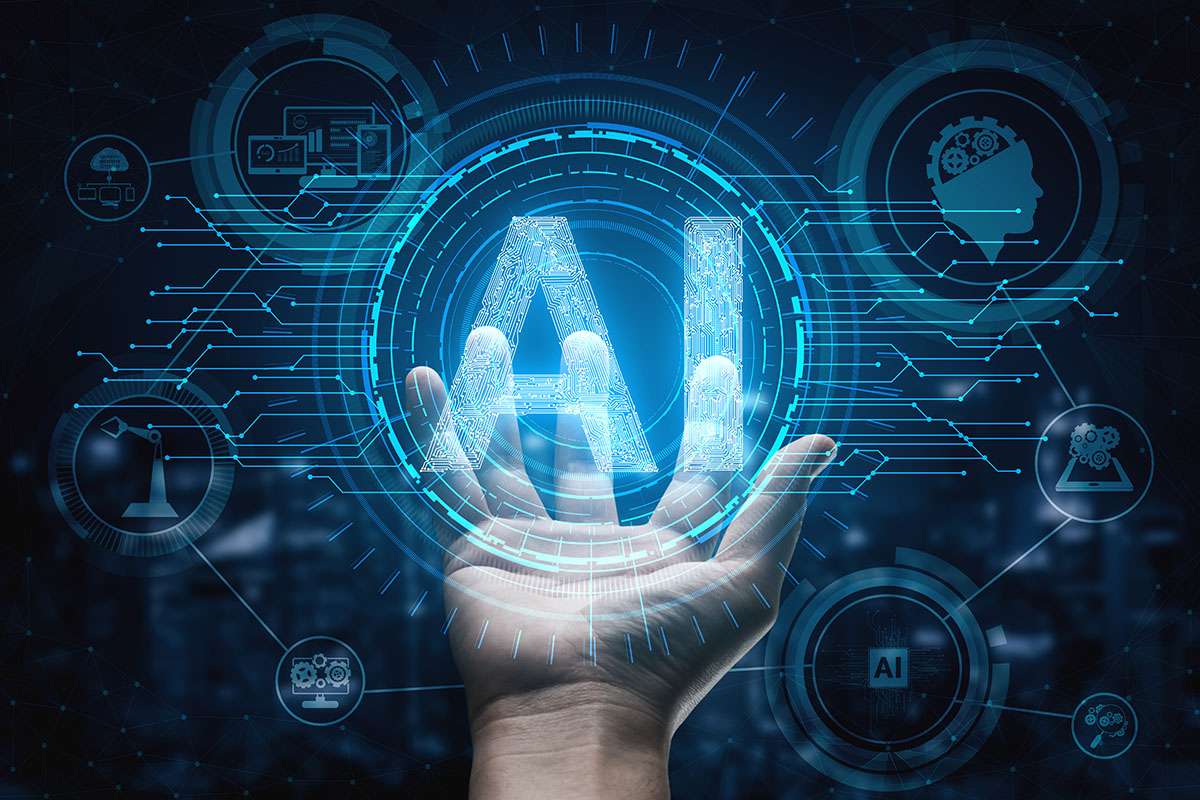Why Changing Business with AI is No Longer Optional
Changing business with AI has moved from science fiction to business necessity in just a few short years. What once seemed like a distant future is now reshaping how companies operate, compete, and grow.
Key ways AI transforms businesses:
- Process Automation: Streamline operations and reduce manual work by up to 70%
- Improved Decision-Making: Analyze vast data sets to uncover insights humans might miss
- Customer Experience: Personalize interactions and predict customer needs in real-time
- Innovation Acceleration: Speed up product development and market analysis
- Cost Optimization: Reduce operational expenses while improving quality and efficiency
- Competitive Advantage: Stay ahead of competitors who haven’t adopted AI solutions
The numbers tell a compelling story. 89% of IT decision-makers are now researching, piloting, or using AI technologies – up from just 72% in 2023. Even more striking, 77% of organizations investing in AI report positive returns on operational efficiency improvements.
But many business leaders miss that AI is more than automation. Today’s AI generates content, predicts market trends, optimizes supply chains, and identifies new revenue streams. Companies using AI report an average 3.5X return on their investments, while those that don’t risk falling behind competitors who adopt these powerful tools.
I’m Ryan Miller, founder of Sundance Networks with over 17 years in IT systems and 10+ in security, I’ve helped countless businesses steer complex technology changes. Changing your business with AI requires the right strategy, security, and implementation to deliver real results. Let me show how to make AI work for you.

What is AI and Why Does It Matter for Your Business?
You’ve probably heard “artificial intelligence” thrown around in every conference and event lately. But what does AI actually mean for your company? Let’s cut through the jargon and get to what really matters.
Defining AI in a Business Context
Think of AI as software that thinks more like humans do. Instead of just following rigid instructions, AI can learn, adapt, and solve problems on its own.
In practical terms, AI acts as your problem-solving partner. It analyzes data faster than any human team could, spots patterns you might miss, and presents clear options for decision-making. The result? Your business runs smoother, and you make better choices based on real insights rather than gut feelings.
Machine Learning is the most common type of AI you’ll encounter. These systems get smarter over time as they process more data. Picture a manufacturing plant using ML to predict when machines need maintenance – catching problems before they cause expensive breakdowns.
Deep Learning takes this further, using complex networks that can handle multiple factors at once. It’s what powers fraud detection systems that analyze dozens of variables simultaneously, getting better at spotting suspicious activity with each transaction.
Predictive vs. Generative AI
Predictive AI is like having a crystal ball backed by solid data. It excels at data analysis and pattern recognition, helping you forecast what’s coming next. Your e-commerce site recommending products based on browsing history? That’s predictive AI working behind the scenes, analyzing customer patterns to boost sales.
Generative AI is the creative powerhouse that’s been making headlines. This technology focuses on content creation and generating new ideas. It can write marketing copy, create product designs, or even draft customer service responses. Think of it as your brainstorming partner who never runs out of fresh concepts.
The key difference? Predictive AI tells you what might happen, while generative AI helps you create what hasn’t existed before.

The Strategic Importance of AI Adoption
Why should AI matter to your business? Because it’s not just another tech upgrade – it represents a fundamental shift in how companies create value and stay competitive.
AI gives you superpowers in areas that matter most. You can now process vast amounts of data that would overwhelm human teams, turning information overload into actionable insights. Those insights help you spot market trends before your competition does, giving you that vital competitive edge.
What’s most exciting is that AI is more than a cost-cutter. It becomes the innovation backbone of your operation. Companies using AI can personalize customer experiences at scale, make faster real-time decisions, and confidently tackle challenges like supply chain disruptions.
The economic shift is already happening. Business leaders who initially saw AI as just a fancy calculator now recognize it as their strategic partner. It’s becoming as fundamental to business success as electricity was to the industrial revolution.
The bottom line? AI adoption isn’t about keeping up with trends, it has value creation and positioning your business for long-term success.
How AI is Actively Changing Business Operations and Strategy
Right now, AI is quietly revolutionizing businesses around the world. It’s not a distant promise, it’s happening today in practical and profound ways.
Driving Unprecedented Operational Efficiency
Think of AI as your most reliable employee, one who loves handling tedious tasks. That’s what makes it so valuable for operational efficiency.
Process automation is where most businesses see immediate results. Nearly half of all AI projects focus on automating routine back-office tasks like digital data entry and document processing. The payoff? Companies free up their human talent for work that requires creativity and strategic thinking.
But AI goes beyond basic automation. In manufacturing, predictive maintenance has become a game-changer. Instead of waiting for machines to break down, AI analyzes machinery data to spot trouble before it happens. It’s like having a working crystal ball for your equipment.
Supply chain optimization is another area where AI shines. Companies use AI to predict demand, optimize delivery routes, and manage inventory with remarkable precision. Some businesses report 15% improvements in logistics costs and 35% better inventory management, which is real money saved.
Even IT departments get a boost. AI-powered IT modernization helps automate operations, leading to average efficiency gains of 22%. It also helps with code generation, making it faster to update legacy systems.
This automation doesn’t just save money—it makes operations smarter and more resilient, letting your team focus on what they do best.
Elevating Decision-Making and Innovation
Here’s where AI starts to feel like magic. It can process vast amounts of data and spot patterns that would take human analysts weeks or months to find.
Data-driven insights are the foundation of smart business strategy. Whether analyzing customer behavior for marketing or tracking consumer sentiment, AI helps extract value from information that might otherwise sit unused.
AI also acts as a powerful decision support system. Banks use AI to send personalized mortgage offers based on customer data, improving satisfaction and conversion rates. Energy companies rely on AI models to predict market conditions, helping traders make faster, more accurate decisions.
When it comes to accelerating innovation, AI shortens development cycles across industries. In healthcare, AI models speed up drug findy by predicting molecular structures. In product development, generative AI helps brainstorm and create initial designs, dramatically reducing time from concept to prototype.
This isn’t just about working faster—it’s about competitive differentiation. AI enables businesses to solve previously unsolvable problems and innovate at a pace that sets them apart from competitors.
Personalizing the Customer Experience
Remember one-size-fits-all customer service? Those days are disappearing, thanks to AI’s ability to personalize every interaction.
AI-powered CRM systems are evolving into self-updating, intelligent platforms that draft emails, analyze customer profiles, and help manage relationships more effectively. It’s like having a personal assistant who never forgets a customer’s preferences.
24/7 customer support via AI chatbots and virtual agents has transformed how businesses handle inquiries. These systems can answer questions, recommend products, and resolve issues around the clock. This doesn’t replace human support—it frees up your team for complex problems that require a human touch.
Targeted marketing has reached new levels of precision with AI analyzing customer behavior and e-commerce data. Instead of broadcasting generic messages, businesses can deliver the right information to the right customer at the right moment, significantly improving conversion rates and satisfaction.
Perhaps most impressively, AI enables proactive engagement. Instead of waiting for customers to call with problems, AI can predict issues before they happen. For example, telecom companies can notify customers about potential network outages before they occur, turning frustrations into exceptional service.
Changing business with AI isn’t just about making internal operations more efficient. It’s about fundamentally changing how we serve customers, creating experiences that feel personal, timely, and genuinely helpful.
Your Roadmap for Changing Business with AI
Changing business with AI might seem overwhelming at first glance, but here’s the truth: every successful AI journey starts with a single, well-planned step. After helping dozens of companies steer this change, I’ve learned that the secret isn’t having the fanciest technology—it’s having the right strategy and mindset.
Think of AI implementation like planning a cross-country road trip. You wouldn’t just hop in your car and start driving, right? You’d map out your route, check your vehicle, and prepare for the journey ahead. The same approach works perfectly for AI adoption.
Developing a Strategy for Changing Business with AI
The most successful AI changes I’ve witnessed all share one thing in common: they started with crystal-clear purpose. Before you even think about algorithms or data models, you need to answer one fundamental question: what specific problem are you trying to solve?

Start by identifying your use cases. Maybe you want to cut customer service response times in half, or perhaps you’re tired of manually processing invoices every month. These concrete, measurable goals give your AI initiative direction and purpose. I always tell clients: don’t implement AI just because everyone else is doing it. Implement it because it solves a real business challenge.
The “start small, think big” approach has saved countless companies from expensive mistakes. Pick one or two high-value pilot projects that align with your core business objectives. This lets you test the waters, learn from real experience, and demonstrate tangible results before investing in larger initiatives.
Securing executive buy-in is absolutely critical—and I mean more than just getting a budget approved. Leadership needs to champion AI adoption throughout the organization. When employees see their CEO actively supporting and using AI tools, they’re much more likely to accept the change themselves.
Here’s something most people don’t realize: successful AI implementation follows what we call the “10-20-70 principle.” Only 10% of your effort should go toward algorithms, 20% toward technology and data infrastructure, and a whopping 70% toward people, processes, and cultural change. This tells us that changing business with AI is primarily about managing human and organizational change, not just technical implementation.
Overcoming Key Implementation Challenges
Let’s be honest, every AI project faces obstacles. The good news? Most of these challenges are predictable and manageable when you know what to expect.
Data quality issues trip up nearly half of all AI initiatives. Your AI models can only be as good as the data you feed them, which means investing in clean, well-organized, and accessible data is foundational. Companies that get their data house in order first can move faster and scale their AI solutions much more effectively.
The talent gap is real, but it’s not impossible. You don’t necessarily need to hire a team of PhD data scientists right away. Many successful companies combine strategic upskilling of existing employees with targeted hiring and partnerships with experienced providers. Your current team already understands your business, they just need to learn how AI can improve their work.
Integration complexity causes headaches for 47% of companies implementing AI. Legacy systems weren’t designed to work with modern AI tools, which sometimes means updating your IT infrastructure. The key is planning these integrations carefully and potentially modernizing systems in phases rather than all at once.
Cost management concerns are understandable, especially when initial AI investments can be substantial. Focus on high-value use cases with clear return on investment, start with pilot projects to prove value, and consider cloud-based AI services to reduce upfront costs.
Change management might be the most important challenge to address. AI often changes how people do their jobs, and that can create anxiety. Clear communication, comprehensive training, and demonstrating personal benefits to employees makes all the difference in smooth adoption.
Navigating the Workforce Shift and Cultivating New Skills
The big question everyone asks: “Will AI take my job?” The answer is more nuanced than most people expect. AI will definitely change how we work, but it’s more likely to transform jobs than eliminate them entirely.
AI excels at automating mundane, repetitive tasks, which actually frees up your team for higher-value activities. For example, AI can handle documentation and data entry, saving significant time that employees can spend on complex problem-solving, strategy, and building relationships with customers.
The most successful companies use AI to augment their workforce rather than replace it. This creates productivity gains that go far beyond simple automation—it allows workers to accomplish things that were previously impossible or too time-consuming.
The skills that become most valuable in an AI-driven workplace are uniquely human: creativity and innovation for generating new solutions, critical thinking for analyzing complex situations, emotional intelligence for working effectively with others, and adaptability for continuous learning as technology evolves.
Data literacy and AI ethics are becoming as important as traditional computer skills. Your team needs to understand how AI works, how to interpret its outputs, and how to apply it responsibly.
Here’s something I’ve noticed: there’s often a “silicon ceiling” where only half of frontline employees regularly use AI tools. Leaders need to actively integrate AI into everyday workflows and create a culture where experimentation with new technology is encouraged and supported.
Managing the Ethical Risks of Changing Business with AI
AI’s power comes with real responsibilities. Ignoring ethical considerations can lead to serious problems—damaged reputation, legal issues, and lost trust from customers and employees.
Bias in AI systems happens when training data contains historical prejudices or gaps. The AI learns these patterns and can perpetuate or even amplify unfair treatment. You need processes to actively identify and correct bias in both your data and AI outputs.
AI “hallucinations” occur when generative AI produces information that sounds convincing but is actually incorrect. This is why human oversight remains essential, especially for critical business decisions or customer-facing applications.
Data privacy and security require extra attention with AI systems. Without proper controls, sensitive company information or customer data could be inadvertently exposed or used inappropriately. Robust data governance and security protocols aren’t just good practice—they’re essential.
Lack of transparency can be problematic when AI systems make decisions that affect employees or customers. Some complex models work like “black boxes,” making it difficult to understand their reasoning. This can undermine accountability and trust.
The solution is establishing clear Responsible AI guidelines and governance processes from day one. This includes continuous monitoring, regular audits, and ensuring compliance with regulations. The goal is balancing speed and innovation with responsibility and trust—because sustainable AI success requires both.
Frequently Asked Questions about AI in Business
How can a small business afford to implement AI?
Here’s the thing – changing business with AI doesn’t require a Fortune 500 budget anymore. That’s one of the biggest misconceptions we encounter, and it’s keeping too many small businesses on the sidelines.
The secret is starting small and being strategic about it. Instead of trying to revolutionize your entire operation overnight, pick one specific problem that’s costing you time or money. Maybe it’s spending hours responding to the same customer questions, or manually sorting through sales data to spot trends.
Cloud-based AI services have been a game-changer for smaller businesses. Platforms like Azure and AWS offer powerful AI tools that you can access without building anything from scratch. You pay for what you use, which means no massive upfront investment. It’s like renting a Ferrari instead of buying one – you get all the power when you need it.
Don’t overlook the data you already have sitting in your systems. Your customer records, sales history, and website analytics are goldmines waiting to be explored. AI can help you extract insights from this existing information without requiring expensive new data collection.
The growing world of open-source AI tools also means you can access sophisticated capabilities without breaking the bank. Plus, when you start with a focused pilot project that delivers clear results, the return on investment often justifies expanding your AI efforts.
We’ve seen small businesses save thousands of hours annually and increase revenue significantly with relatively modest AI investments. The key is proving value first, then scaling up.
Will AI make human creativity obsolete?
This question always makes us smile because it reveals a fundamental misunderstanding of what AI actually does. Changing business with AI isn’t about replacing human creativity – it’s about supercharging it.
Think about what generative AI really does. It learns from existing patterns and recombines them in new ways. That’s impressive, but it’s not true creativity. It can’t experience emotions, understand cultural nuances, or come up with genuinely groundbreaking ideas that challenge existing assumptions.
What AI excels at is handling the tedious stuff that bogs down creative work. Instead of spending hours drafting initial content or researching background information, you can use AI to handle those tasks and focus on the strategic thinking, emotional connection, and innovative problem-solving that only humans can do.
We’ve watched AI become an incredible brainstorming partner for our clients. It can generate dozens of variations on an idea, helping spark new directions you might not have considered. It’s like having a tireless research assistant who never gets bored with repetitive tasks.
AI is also opening up entirely new creative possibilities. Artists are using AI to explore visual concepts they couldn’t create before. Marketers are experimenting with personalized content at scales that were previously impossible.
The future belongs to people who learn to collaborate with AI, not compete against it. When you combine human insight, empathy, and strategic thinking with AI’s processing power and pattern recognition, that’s where the real magic happens.
What is the single most important factor for a successful AI project?
After working with organizations of all sizes on AI implementation, we can tell you it’s not what most people expect. It’s not having the fanciest technology, the cleanest data, or the biggest budget.
The single most critical factor is people, processes, and cultural change. This might sound surprising, but it aligns perfectly with what industry research shows – successful AI adoption follows the 10-20-70 principle. Only 10% of your effort should go toward algorithms, 20% toward data and technology, and a full 70% toward the human side of change.
Here’s why this matters so much. You can have the most sophisticated AI system in the world, but if your team doesn’t understand why they should use it, how it benefits them personally, or if they’re afraid it’s going to replace them, your project will struggle.
Strong leadership makes all the difference. When CEOs and executives actively champion AI initiatives and communicate their vision clearly, adoption rates soar. Employees need to see that leadership is committed and that AI is meant to make their jobs better, not eliminate them.
Change management becomes absolutely crucial. This means redesigning workflows, redefining job roles, and actively helping people develop new skills. It’s about showing your team how AI will free them from mundane tasks so they can focus on more meaningful, strategic work.
Trust and ethics play a huge role too. When people understand that AI is being implemented responsibly, with proper safeguards and transparency, they’re much more likely to accept it.
The organizations that succeed with AI are the ones that treat it as a people challenge first and a technology challenge second. Get the human elements right, and the technology will follow.
Your Next Steps in AI Change
Think about it: just a few years ago, the idea of having a conversation with your computer seemed ridiculous. Today, AI is writing emails, predicting equipment failures before they happen, and helping doctors diagnose diseases faster than ever before. We’re moving rapidly toward a world where our environment itself becomes the interface, where AI doesn’t just live on screens but seamlessly integrates into everything we do.
The window for getting ahead of this change is closing fast. Companies that treat AI as just another software tool are missing the bigger picture. This technology is fundamentally reshaping how we work, compete, and create value. The businesses thriving five years from now will be the ones that started their AI journey today.
Here’s what we’ve learned from helping countless organizations steer this change: success isn’t about having the fanciest algorithms or the biggest data sets. It’s about approaching AI with the right mindset and strategy.
Accept AI as your strategic partner, not just a cost-cutting tool. Yes, it can automate repetitive tasks and save money. But its real power lies in helping you solve problems you couldn’t tackle before and find opportunities you didn’t know existed.
Focus on change, not just improvement. The companies seeing 3X returns on their AI investments aren’t just making their existing processes 10% better. They’re reimagining entire workflows, creating new revenue streams, and delivering customer experiences that seemed impossible just a few years ago.
Your people remain your greatest asset. The most successful AI implementations happen when employees feel empowered, not threatened. When you invest in upskilling your team and designing human-AI collaboration that makes everyone’s job more interesting and impactful, that’s when the magic happens.
Build trust through responsible AI practices. As AI becomes more powerful, being transparent about how you use it, protecting customer data, and ensuring fair outcomes isn’t just the right thing to do—it’s essential for long-term success.
At Sundance Networks, we’ve spent years helping businesses of all sizes harness the power of smart technology, scalable AI, and robust security. We believe technology should work for people, not the other way around. Whether you’re a small business looking to automate customer service or an enterprise ready to transform your entire operation, we’re here to guide you through every step of the journey.
Ready to explore how AI can revolutionize your operations, improve your customer experience, and drive your growth from concept to cash flow?





